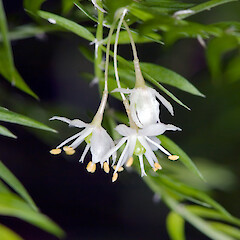Asparagus scandens
Common name
climbing asparagus
Family
Asparagaceae
Flora category
Vascular – Exotic
Structural class
Lianes - Monocots
NVS code
The National Vegetation Survey (NVS) Databank is a physical archive and electronic databank containing records of over 94,000 vegetation survey plots - including data from over 19,000 permanent plots. NVS maintains a standard set of species code abbreviations that correspond to standard scientific plant names from the Ngä Tipu o Aotearoa - New Zealand Plants database.
ASPSCA
Conservation status
Not applicable
Habitat
Terrestrial. Found in lowland and coastal forest, shrublands, mature broadleaf/podocarp forests especially those of light to moderate shade, streams, coastal areas, shrublands, epiphytic niches, roadsides, gravel pits/quarries, farm hedges, house gardens and wasteland areas. Can infest unmodified and fully intact forest.
Wetland plant indicator status rating
Information derived from the revised national wetland plant list prepared to assist councils in delineating and monitoring wetlands (Clarkson et al., 2021 Manaaki Whenua – Landcare Research Contract Report LC3975 for Hawke’s Bay Regional Council). The national plant list categorises plants by the extent to which they are found in wetlands and not ‘drylands’. The indicator status ratings are OBL (obligate wetland), FACW (facultative wetland), FAC (facultative), FACU (facultative upland), and UPL (obligate upland). If you have suggestions for the Wetland Indicator Status Rating, please contact: [Enable JavaScript to view protected content]
FACU: Facultative Upland
Occasionally is a hydrophyte but usually occurs in uplands (non-wetlands).
Detailed description
Slender scrambling or climbing perennial. Tuberous roots. Stems 2-4 m long, green and much branched at the top, thin and wiry. Leaves are flat cladodes (resembling miro), usually in threes at each node, 5-15 mm x 1-1.5 mm. Flowers tiny, whitish, Sep-Dec. Round berry, 8 mm diam, green turning orange-red, Oct-Feb, with 1-2 seeds.
Similar taxa
Leaf-like cladodes in flat planes separate A. scandens from other asparagus species in NZ.
Flowering
September, October, November, December
Flower colours
White
Fruiting
January, May, August (Timmins & MacKenzie 1995).
Life cycle
Perennial. The flower is hermaphrodite (Timmins & MacKenzie 1995). Reproduces from seed and vegetatively by the transport of tuberous roots (ibid.). Seed is dispersed by birds; tubers spread by soil movement, garden dumping and human activity (ibid.).
Year naturalised
1970
Origin
trop & S Africa
Reason for introduction
Ornamental.
Tolerances
Tolerant to heavy shade, but matures and fruits in moderate shade to full light. Wide range of moisture tolerance. Tubers resprout in response to physical damage.
Etymology
asparagus: An old Greek name for this plant possibly derived from a- (an intensifier) and sparasso ‘to tear’, referring to the prickles of some species
scandens: Climbing; from the Latin scandere; groth habit
National Pest Plant Accord species
This plant is listed in the 2020 National Pest Plant Accord. The National Pest Plant Accord (NPPA) is an agreement to prevent the sale and/or distribution of specified pest plants where either formal or casual horticultural trade is the most significant way of spreading the plant in New Zealand. For up to date information and an electronic copy of the 2020 Pest Plant Accord manual (including plant information and images) visit the MPI website.











